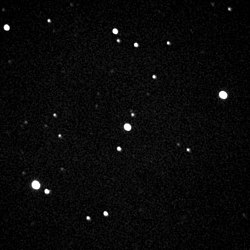Star in the constellation Andromeda
WASP-1 is a magnitude 12 binary star system located about 1,250 light-years away[ 2] Andromeda constellation .[ 7] metal-rich F-type main-sequence star , named WASP-1A, and a distant low-mass star, named WASP-1B. WASP-1A has one known transiting hot Jupiter exoplanet named WASP-1b .
Stellar companion
WASP-1A has a distant companion star, named WASP-1B. WASP-1B is a low-mass star that is around 0.3 times as massive as the Sun and has an effective temperature of about [ 6] : 24 angular separation of about 4.6 arcseconds , corresponding to a projected distance of 1587 AU.[ 6] : 13, 15 proper motion of WASP-1A, indicating the two stars are gravitationally bound to each other.[ 6] : 15
Planetary system
In 2006, an extrasolar planet was discovered by the Wide Angle Search for Planets team using the transit method .[ 4] 3 , making it about half as dense as Saturn, and one third as dense as water. The orbit of WASP-1b is inclined to the rotational axis of the star by 79.0+4.3 −4.5 [ 8]
Two searches for additional planets using transit-timing variations have yielded negative results.[ 9] [ 10]
See also
References
^ Roman, Nancy G. (1987). "Identification of a constellation from a position" . Publications of the Astronomical Society of the Pacific 99 (617): 695. Bibcode :1987PASP...99..695R . doi :10.1086/132034 Constellation record for this object at VizieR .^ a b c d e f Vallenari, A.; et al. (Gaia collaboration) (2023). "Gaia Data Release 3. Summary of the content and survey properties" . Astronomy and Astrophysics . 674 : A1. arXiv :2208.00211 Bibcode :2023A&A...674A...1G . doi :10.1051/0004-6361/202243940 S2CID 244398875 . Gaia DR3 record for this source at VizieR .^ a b c d Torres, Guillermo; Winn, Joshua N.; Holman, Matthew J. (2008). "Improved Parameters for Extrasolar Transiting Planets". The Astrophysical Journal . 677 (2): 1324– 1342. arXiv :0801.1841 Bibcode :2008ApJ...677.1324T . doi :10.1086/529429 . S2CID 12899134 . ^ a b Cameron, A. Collier; et al. (2007). "WASP-1b and WASP-2b: two new transiting exoplanets detected with SuperWASP and SOPHIE" . Monthly Notices of the Royal Astronomical Society . 375 (3): 951– 957. arXiv :astro-ph/0609688 Bibcode :2007MNRAS.375..951C . doi :10.1111/j.1365-2966.2006.11350.x S2CID 735515 . ^ a b "TYC 2265-107-1" . SIMBAD Centre de données astronomiques de Strasbourg . Retrieved 2009-05-20 .^ a b c d e f g h i Ngo, Henry; Knutson, Heather A.; Hinkley, Sasha; Crepp, Justin R.; Bechter, Eric B.; Batygin, Konstantin; et al. (February 2015). "Friends of Hot Jupiters. II. No Correspondence between Hot-jupiter Spin-Orbit Misalignment and the Incidence of Directly Imaged Stellar Companions" . The Astrophysical Journal . 800 (2): 22. arXiv :1501.00013 Bibcode :2015ApJ...800..138N . doi :10.1088/0004-637X/800/2/138 ^ Stempels, H. C.; et al. (2007). "WASP-1: a lithium- and metal-rich star with an oversized planet" . Monthly Notices of the Royal Astronomical Society . 379 (2): 773– 778. arXiv :0705.1677 Bibcode :2007MNRAS.379..773S . doi :10.1111/j.1365-2966.2007.11976.x S2CID 17565024 . ^ Simpson, E. K.; Pollacco, D.; Cameron, A. Collier; Hébrard, G.; Anderson, D. R.; Barros, S. C. C.; Boisse, I.; Bouchy, F.; Faedi, F.; Gillon, M.; Hebb, L.; Keenan, F. P.; Miller, G. R. M.; Moutou, C.; Queloz, D.; Skillen, I.; Sorensen, P.; Stempels, H. C.; Triaud, A.; Watson, C. A.; Wilson, P. A. (2011). "The spin-orbit angles of the transiting exoplanets WASP-1b, WASP-24b, WASP-38b and HAT-P-8b from Rossiter-Mc Laughlin observations★" . Monthly Notices of the Royal Astronomical Society . 414 (4): 3023– 3035. arXiv :1011.5664 Bibcode :2011MNRAS.414.3023S . doi :10.1111/j.1365-2966.2011.18603.x S2CID 46522188 . ^ Granata, V.; et al. (2014). "TASTE IV: Refining ephemeris and orbital parameters for HAT-P-20b and WASP-1b". Astronomische Nachrichten . 335 (8): 797– 803. arXiv :1405.3288 Bibcode :2014AN....335..797G . doi :10.1002/asna.201412072 . S2CID 118341059 . ^ Maciejewski, G.; et al. (2014). "Revisiting Parameters for the WASP-1 Planetary System" (PDF) . Acta Astronomica . 64 (1): 11– 26. arXiv :1402.6518 Bibcode :2014AcA....64...27M . ^ Bonomo, A. S.; et al. (2017). "The GAPS Programme with HARPS-N at TNG . XIV. Investigating giant planet migration history via improved eccentricity and mass determination for 231 transiting planets" . Astronomy and Astrophysics . 602 . A107. arXiv :1704.00373 Bibcode :2017A&A...602A.107B . doi :10.1051/0004-6361/201629882 . S2CID 118923163 .
External links














